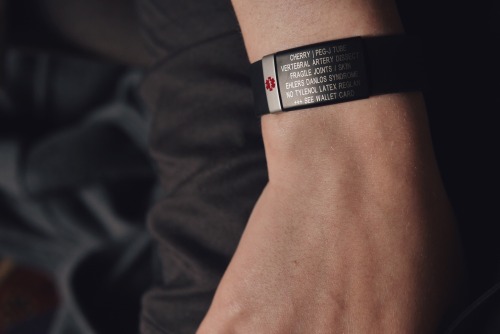#medical bracelet
At the start of my treatment, I was given these 2 cards (that I need to carry on me at all times):

One is to say that I have been treated with Lemtrada, and gives a brief explanation of why I have had this treatment, what it is and outlines any (known) potential side effects. This card came with a Lemtrada information pack, created by Genzyme and MS One to One, that was originally given to me when deciding whether or not to go ahead with the treatment. I will need to carry this card with me for 4 years after my last treatment dose:

The red card explains that if I need a blood transfusion, I will need irradiated blood. This is something that will have to happen indefinitely, and as I always lose things, I bought a medical alert bracelet as well:

The metal part comes from Lauren’s Hope, and I have decided (for the moment) to use an old pura vida bracelet, but will decide later on whether or not to get a ‘proper’ bracelet part. They’re pretty expensive though, and this way I can change the bracelet when and as I like.
It’s world Stroke Day today. Two years ago and one month I had a dissection (rupture) in an artery in my neck. This temporarily cut off blood supply to my brain, similarly to how a blood clot would. Mine is a rarer form of stroke, and my dissection was spontaneous (no trauma) due to the fact that my blood vessels are weakened by my faulty collagen.
This is extremely rare, BUT! That doesn’t mean perfectly normal young people aren’t at risk of strokes too. Strokes aren’t just old people. 25% of strokes are in people under the age of 45. The dissection that happened in my neck, can also happen in perfectly healthy people from trauma (usually weightlifting, moderate car accidents or even chiropractic adjustments). Young people can also suffer from blood clots (the usual cause of stroke in most people).
Know the signs. They’re not always as obvious as the common acronyms proclaim (FAST). In my first stroke I had no one-sided weakness or numbness that I noticed. I DID have vision loss, severe sudden headache, and dizziness (that I get a lot of anyways). I also experienced confusion and a sense of DREAD like I have never felt before. I missed my stroke and so did the ER triage.
I was extremely lucky that my blood flow went back to normal on its own as it was something like 8-9 hours before I got to see a doctor. Don’t let the same happen to you!
My second stroke DID include one sided weakness, but it was extremely brief. Stroke is not always as obvious as you’d expect (as in the more common severe face drooping and speech difficulties). Be aware. Thankfully the ER doctor I finally saw knew right away what was probably going on.
I feel incredibly lucky to be a stroke survivor! ❤️
{please don’t remove my caption!}
Post link


